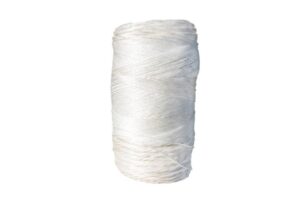The type of twine used on your bales can significantly impact how your bales fare during transport and storage. It’s also essential to consider tensile strength when selecting your twine.
With his baling machinery, Youtuber One Lonely Farmer recently tested both PowerPress twine and Black Label twine – recycled from post-industrial waste. He found both to perform well without any mechanical problems.
Polypropylene
 Baler twine is a string that helps compact hay, straw and other crops into round or rectangular durable baler twine. It is also used to mend fences and reattach tractor parts. There are many types of baler twine, including natural and synthetic varieties. The difference between the two types is that natural twine is woven using raw materials such as cotton, sisal or a combination. In contrast, synthetic baler twine is made from artificial fibres.
Baler twine is a string that helps compact hay, straw and other crops into round or rectangular durable baler twine. It is also used to mend fences and reattach tractor parts. There are many types of baler twine, including natural and synthetic varieties. The difference between the two types is that natural twine is woven using raw materials such as cotton, sisal or a combination. In contrast, synthetic baler twine is made from artificial fibres.
The synthetic baler twine manufacturing process uses polypropylene (PP) and other raw materials to create a strand with the necessary strength and durability for its intended use. PP is hardy and durable, resisting cracking and stress. It is also water-resistant and can withstand some chemicals and acids. The colour of the twine can be varied, and it is usually UV-stabilized to protect against premature degradation due to exposure to sunlight.
Various polypropylene durable baler twine types are available, with different colours and tensile strengths. The most popular PP twine is black but can also be found in green, blue and orange. Coastal tip: Always check the guaranteed number of feet per carton when selecting a cord. This will ensure you don’t run out of twine before finishing your baling job.
While synthetic twine is economical, it has some drawbacks that farmers should be aware of. It doesn’t decompose quickly and can linger in the environment for years, posing a potential health risk. In contrast, biodegradable twines, typically made from jute or sisal, break down within a few years and are a more environmentally-friendly option.
In addition to its benefits, polypropylene durable baler twine is also rot-resistant and resistant to mould and mildew. It is also easy to work with and can be rolled up or knotted. Its smooth texture prevents the knot from slipping and has a high tensile strength of 110, making it ideal for various applications. It can be purchased at farm supplies stores and co-ops. In addition, this twine can be purchased in hi-visibility orange to help workers see it better.
Sisal
Sisal is a natural plant fibre that is used to make twine. It is challenging, solid and durable, able to stretch over long distances. It is a good choice for baling as it can bind round and square bales. It is also helpful for mending fences and can be used in various ways. It can be dyed to match any colour scheme and is resistant to corrosion in seawater. It can also be treated to prevent rot and mildew and be rodent-resistant. It is often woven into ropes and is an essential ingredient in the textile industry.
Sisal baling twine is an excellent alternative to polypropylene twine. It is made from natural plant fibres that are biodegradable and rot-resistant, making it a better choice for those who want to protect their animals. It can be purchased from farmers’ supply stores and co-ops. It can be used for round and square balers in different colours and thicknesses.
Baling twine is a versatile and crucial item for any farmer’s toolbox. It can tie up hay or straw bales, mend fences, and even replace metal wire fencing. It is also helpful for storing cereal crops and is commonly found in cattle feedlots.
The most common type of baler twine is made from polypropylene, a thermoplastic made from propylene monomers. It is challenging and rot-resistant, making it an excellent option for those needing to handle their bales frequently. It is also available in various colours, making it easier to identify bales and differentiate between them.
In addition to being durable baler twine is highly tensile and knot-resistant. It is also treated to resist rot, mildew, rodents, and insects. The types of dye and stabilizing additives used vary according to the conditions where they will be used. For example, mild conditions require blue or orange baler twine, while hotter environments require red. It is available in various packaging sizes, including spools and reels.
UV Stabilized
If you’re baling hay, it is essential to use UV-protected twine. This will prevent the grass from absorbing moisture and dust that may cause it to deteriorate or mould. It will also protect the hay from sunlight, which can damage twigs. It will also help the twigs remain healthy and robust when the grass is stored outside.